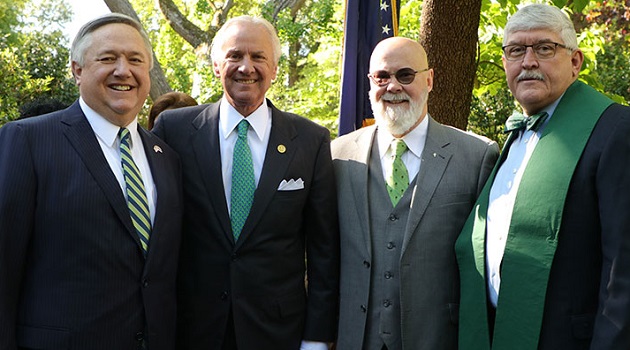Five Questions for S.C. Floodwater Commission Chairman Tom Mullikin
By Alex Junes-Ward
Less than two weeks after the statewide tree-planting effort, POWERPLANTSC, in which some 3.4-million loblolly pine tree seeds (and some saplings) were distributed to sites and organizations in all of South Carolina’s 46 counties, and planted on Earth Day, Apr. 22, we sat down with S.C. Floodwater Commission Chairman Tom Mullikin to discuss and assess the success of the venture.
POWERPLANTSC was strongly supported – and enjoyed active participation – by S.C. Gov. Henry McMaster, Lt. Gov. Pamela Evette, a number of state legislators, university presidents, and a whole host of government agencies and public and private sector partners.
We wanted to know how success was measured? Was a new state record achieved? What is Mullikin planning next.
QUESTION: By all accounts, POWERPLANTSC was a huge success. How do you personally gauge the success of this project?
MULLIKIN: First of all, we wanted the broadest possible collaboration and partnership in all 46 counties. We clearly achieved that: We enjoyed overwhelming support from 125,000 volunteers in all 46 counties. While we planted a national record number of trees in one day, we also educated and activated tens of thousands of South Carolinians to become involved in protecting our beautiful environment.
QUESTION: You mention the new state record – and one of the subordinate goals of POWERPLANTSC – which was the 3.4-million tree seeds planted in a single day or at least three-million-plus. Was the record indeed set? And how do we know for recording purposes. How was your team able to verify the numbers?
MULLIKIN: Yes, the record number of trees were planted. We confirmed this with our partners and we are confident that our seeds, saplings and trees were planted.
QUESTION: Let’s talk about future flood mitigation: The primary goal was having trees planted in all 46 counties which would help mitigate future floods in the Palmetto State. Will these trees in fact be an effective means of absorbing water? Are there additional ways in which they will help protect the state from disastrous flooding?
MULLIKIN: The planting of trees is an important step in protecting against flooding as one tree absorbs approximately 11,000 gallons of water annually. One tree also sinks one metric ton of carbon dioxide over the life of the tree. In this, we also created a 3.4-million ton carbon sink.
QUESTION: What have you heard personally about the success of this venture? What is it that has perhaps been missed in the discussions of the tree-planting effort?
MULLIKIN: We have heard personally from many teachers and students about the profound educational impact of the tree planting, and education was also another of our key goals. The vitally important education piece coming out of this venture will impact the next generation of South Carolina leaders as to the importance of conservation and environmental protection. We’re seeing more of these young people wanting to be involved. And that is personally encouraging to me.
QUESTION: What’s next for Tom Mullikin in the long term and the short?
MULLIKIN: We will continue working on building an artificial reef along the South Carolina coastline and we will continue monthly river and creek cleanups. We are also excited about the upcoming SC7 [SOUTH CAROLINA SEVEN] expedition across the Palmetto State from the mountains to the sea. That will be in July. And then there is the forthcoming release of our documentary Higher Ground showcasing our SC7 expedition in 2020.
Please see the SC7 trailer here – https://vimeo.com/458953930
– Pictured (L-R) Dr. Mark A. Smith, president of Columbia International University (CIU); Gov. McMaster, Chairman Mullikin, and CIU Professor Mike Langston (Photo by Bob Holmes, CIU)



